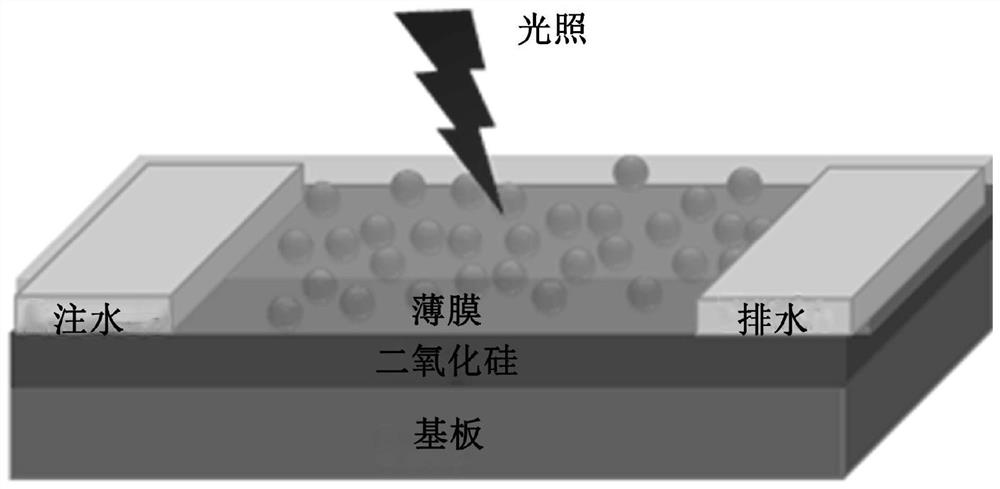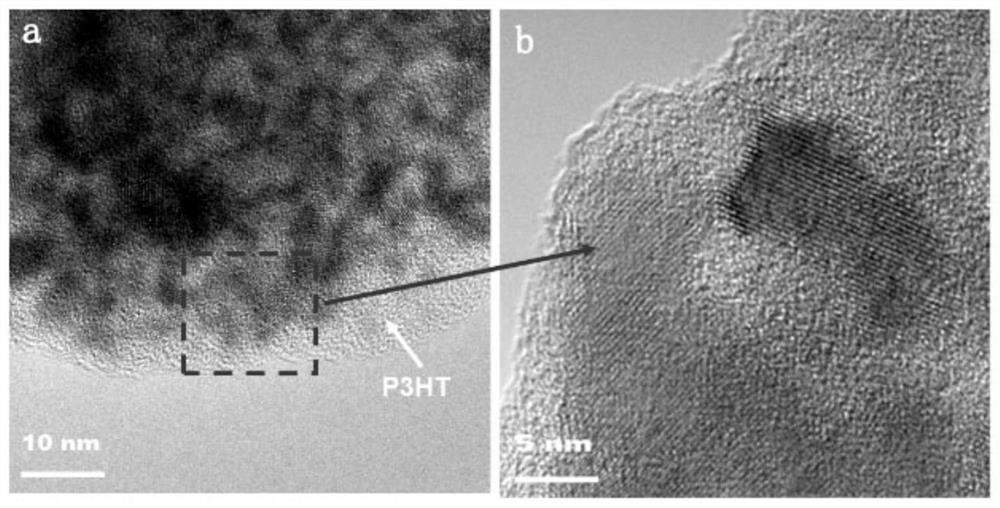Hybrid phototransistor constructed by poly (3-hexylthiophene) and mercury telluride quantum dots and preparation method and application thereof
A technology of phototransistor and hexylthiophene, which is applied in the field of photoelectric detection, can solve the problems of low efficiency and achieve the effects of reduced noise level, good gate voltage tuning, and low sensitivity
- Summary
- Abstract
- Description
- Claims
- Application Information
AI Technical Summary
Problems solved by technology
Method used
Image
Examples
Embodiment 1
[0042] A hybrid phototransistor-type near-infrared photodetector constructed of poly(3-hexylthiophene) and mercury telluride quantum dots and a preparation method thereof, characterized in that it comprises the following steps:
[0043] 1. Electrolysis of telluride to obtain hydrogen telluride gas;
[0044] 2. Add 1.9g of mercuric chloride (HgCl 2 ) was dissolved in 250 mL DMF (dimethylformamide), and 75 mL DPE (1,2-bis(diphenylphosphine) ethane), 5 mL TEA (triethanolamine) and 2.4 mL FMT (O-((9H -fluoro-9-yl)methyl)S-(2-mercaptoethyl)carbonate);
[0045] 3. Add the gas obtained in 1 to the solution obtained in 2, first stir at 3°C for 1 hour, then stir while raising the temperature to room temperature, and finally raise the temperature to 40°C and stir until the fluorescence wavelength of the obtained product is 2400nm;
[0046] 4. Add the solution obtained in 3 into the mixed solution of ethyl acetate and hexane, stir for 20 minutes, centrifuge to obtain a precipitate, a...
Embodiment 2
[0069] The steps in this embodiment are basically the same as in Example 1, the difference is that in step 1, the mercuric chloride added is 2.3g, DPE is 60mL, TEA is 10mL and FMT is 1.5mL; in step 3, stirring The temperature is 8°C, the time is 45min, and the fluorescence emission reaches 2600nm; in step 4, the stirring time is 40min, and the drying time is 6min; in step 5, the volume of DMSO is 40mL, and the ultrasonic time is 5min; in step 6, The volume of TCE is 10mL, the volume of DDT is 6mL and the volume of formamide is 4mL, the volume of DMSO is 50mL, and the standing time is 40min; in step 7, the drying time is 20min; in step 9, dissolve for 20min, add poly(3- Hexylthiophene) and stirred at 60°C for 6h; in step 10, the deposition rate was 1500 rpm for 20s; in step 11, 1500 rpm for 20s; in step 12, annealed at 40°C for 15min.
[0070] The prepared P3HT:HgTe QD hybrid phototransistor was tested by scanning electron microscope, transmission electron microscope, high-reso...
PUM
 Login to View More
Login to View More Abstract
Description
Claims
Application Information
 Login to View More
Login to View More - R&D
- Intellectual Property
- Life Sciences
- Materials
- Tech Scout
- Unparalleled Data Quality
- Higher Quality Content
- 60% Fewer Hallucinations
Browse by: Latest US Patents, China's latest patents, Technical Efficacy Thesaurus, Application Domain, Technology Topic, Popular Technical Reports.
© 2025 PatSnap. All rights reserved.Legal|Privacy policy|Modern Slavery Act Transparency Statement|Sitemap|About US| Contact US: help@patsnap.com



